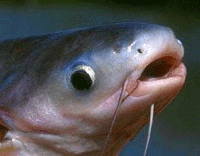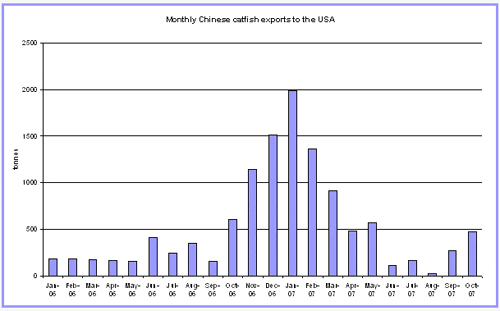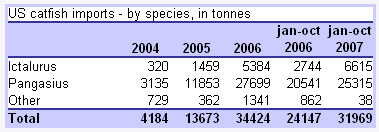US domestic catfish production declining
In 2003, production hit a record level of 300 000 tonnes, but this year, total production is estimated at around 200 000 tonnes. As for many other commodities, the US catfish production is influenced by the decision of farmers to grow agricultural crops rather than catfish, in view of expanding demand and higher prices of these products (bio fuel).
On the other hand, catfish production is expanding in China. Total catfish production in 2007 is exceeding 20 000 tonnes, taking the export figures to the USA as a basis of calculation. In the first ten months of 2007, total catfish exports from China to the USA reached 6 400 tonnes, mainly frozen fillets. This figure is almost 3 times the corresponding 2006 figure, which gives an idea on the growth rate of this species in China. However, in the past four months imports were a modest 1 000 tonnes, as catfish was put by the FDA on the list of five species, for which all the shipments from China are controlled. As for the other species hit by this regulation, China preferred not to ship the commodity, rather than be subject to lengthy and costly controls.
Higher catfish imports into the USA
 |
After months of product recalls and fears over contaminated food imports, the US and Chinese governments reached a food and drug safety agreement on 12.12.2007 that will give American inspectors access to Chinese factories while assuring Chinese manufacturers continued access to the US market. Under the new agreement, Chinese exporters to the U.S. will register with the Chinese government and agree to annual inspections by China's office of General Administration of Quality Supervision, Inspection and Quarantine. This new agreement will include cultured seafood, such as shrimp and catfish. This new agreement should help to normalize the catfish trade between the two countries. The graph below shows in a very impressive manner, the drop in Chinese catfish exports to the USA after the FDA control measure started in June 2008.


Total catfish imports into the USA reached 32 000 tonnes in the first ten months of 2007, which is 32% more than in the same period of 2006. These figures include both channel catfish and pangasius. In addition to China, already described above, Thailand is expanding its catfish, mainly pangasius, exports to the US market, while Malaysian exports decline. Malaysian producers of catfish find a more lucrative market in their own country rather than venturing into export trade.

Since 2004, when catfish imports into the USA were first divided by species, pangasius also accounted for the bulk of the imports. Its share increased from 79% in 2004 to 86% in 2005. After this date, however, increasing influx of Ictalurus catfish from China led to less importance of pangasius catfish in total US imports. At present, the share has returned to 79%. As the Chinese production is based on imported brood stock from the USA, the US producers are unable to claim that it is a different species; therefore Chinese imported catfish can be sold in the USA under the channel catfish trade name, however, due to the COOL (country of origin regulation) China as the producing country has to be indicated. Catfish fillets from China are generally selling about US$ 0.10/lb lower than pangasius fillets from Viet Nam. At present, the price of Vietnamese frozen pangasius fillets is between US$ 2.25-2.45/lb, while Chinese fillets quote at US$ 2.15-2.35/lb.
Higher prices likely in 2008
Prices of catfish in the US market have gone up, though very slowly in the course of 2007, and a further increase is likely in the coming year. This is mainly due to lower domestic production and strong demand.

